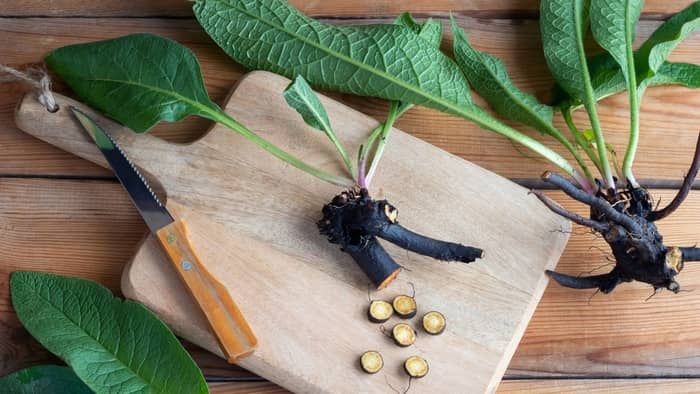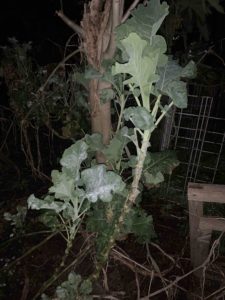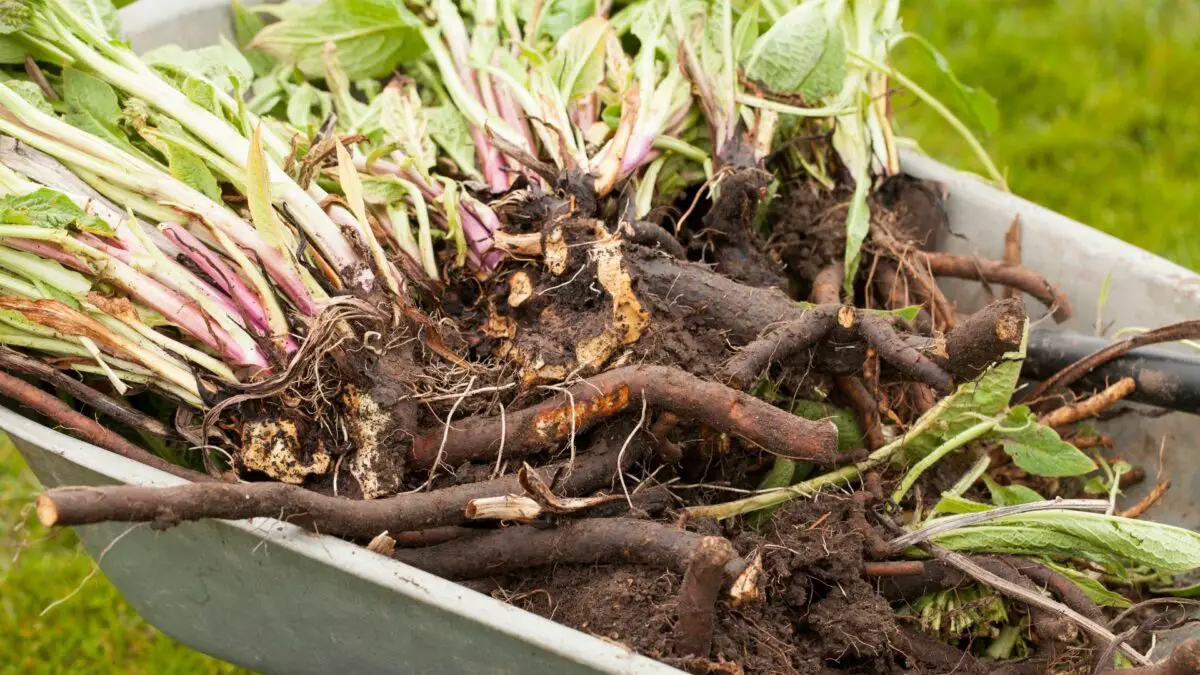Last Updated on March 2, 2023 by Griselda M.
Let’s have a look at a few examples of deep root plants. Roots bring nutrients to the plant – and a lot of the surface layers of soil on our planet have been farmed for so long now that the nutrient levels are very depleted. Deep-rooted plants mine essential trace elements from deep in the subsoil and bring these to the surface. Growing the right deep-rooted plants helps us get the maximum nutritional value out of our soils – be that in soils or a deep pot. Join me as we explore how to plant deep-rooted plants to keep your garden and yourself healthy.
Plant with Deepest Roots
Ever wondered about a plant with the deepest roots? We all know that several trees probe deep into the earth in search of water and nutrients that are not easily accessible at the surface. These plant roots can penetrate cracks in rocks and travel hundreds of feet below to satisfy their search.
An aspect to consider is the depth of plant roots, as according to the species you’re growing and the conditions of the soil, this growth can vary. This is because individual plants behave differently during climate change. While some are hardy and adapt easily, others do not, even if their roots have the potential to delve deep into the earth.
When it comes to plants that have the deepest roots, the Shepherd’s Tree is number one. This plant is documented as the species with the deepest roots, with a more than 70-meter depth. Known by its scientific name Boscia Albitrunca, this tree is a Kalahari Desert Native. The depth of Shepherd’s tree roots was discovered by a groundwater well dillers that stumbled upon them accidentally.
How Have Our Soils Become Dead?
I remember as a little boy I could take an apple, take a bite of it, and within 15 minutes the flesh around that apple would become brown and oxidized. This is due to large amounts of activity by an enzyme called polyphenol oxidase which has copper at the heart of its structure. Copper and many other minerals are showing declines in availability in soils. Nowadays if you bite an apple, you can leave it and come back a day later and it still has not oxidized. There is a recorded decline in nutrients in apples over the past few decades.
This may be due to the depletion of soils, or it may be due to things we put in the soil such as herbicides binding these minerals. In many cases, it is due to poor land management and people not growing plants with deep roots to bring nutrients from the subsoil to the surface and replenish the soil. In tlhis article, we will look at examples of deep-rooted plants, and how these plants can help to increase your garden’s productivity and the nutritional qualities of your produce.
Examples Of Deep-rooted Plants
I have a few favorite examples of deep-rooted plants that I use to bring nutrients to the surface and regenerate my soils. Let us go through this list of magical mineral lifters.
Example 1: Comfrey
This is one of my favorite examples of deep-rooted plants. I grow it for one main reason being that it has roots that extend 6’7 (2m) into the soil. That is a lot of root power, and this plant brings trace elements to the surface in abundance. It also brings phosphates, potassium, calcium, iron, and other macro-nutrients to the surface.
When we talk about examples of deep-rooted plants you cannot get much better than comfrey. I have a little system with comfrey – I collect bunches of it and hang them from a noose rope in my chicken cage every second day. The chickens flatten this in a matter of minutes! They crave the minerals and protein in this wonderful plant. The chicken litter in the cage is now enriched as well, and when I put that on my vegetables it has all the magic of comfrey compost – and the mystical magic that those little chicken feet and intestines add to anything they eat. Chickens turn normal garden waste into super fertilizer.

Learn more about 15 Plants With Fibrous Roots System
Example 2: Kale
Kale is an amazing example of a deep-rooted plant. Depending on where you are in the world this thing can be a perennial. I spent a bit of time working in Zambia once, and in the rural African villages in this beautiful country, the people don’t even grow kale from seeds. The plants get long stems with time, and the stems produce branches that branch off the main stem. If you cut these and place them in the ground they grow.
With the proliferation of farmed SEO content on the internet, it is increasingly difficult to actually find a genuine indication of what the length of kale roots is. I will rather go from personal experience because I know this to be true. My first kale patch is now a citrus grove. The section of the garden where I planted the kale in a built-up section where deep river sand had been trucked in to build the section up by about 6 feet (1.8m). I dug three huge holes to get to the bedrock at the base, which ended up being just a little deeper than the above retaining wall. The kale roots from the plants that were at the top of this bed extended to the base of these holes. From this, we can conclude that given time, kale roots will penetrate over 6 feet into decent soft soil.

These scraggly diseased kale plants in my garden are excellent examples of deep-rooted plants. They have been producing nutrient-rich chicken leaves AND acting as an aphid sponge for two years. I go to the plants and harvest the leaves with the most aphids on them and feed these to the chickens. This helps draw aphids away from other plants in the garden and provides the chickens with an insect-boosted salad.
Kale, again, passes the chicken test – if you give this plant to them, they devour it and it makes for huge eggs with strong shells. Hence you will remember I mentioned I feed comfrey to my chickens every second day – the day in between comfrey day is kale day. This allows them to get a balanced diet. Chickens are funny things – if you give them kale and comfrey at the same time, they eat less of either. I find giving the plants on separate days helps to ensure maximum eating of the leaves.
Example 3: Alfalfa/lucern
This is the king of deep-rooted things you can grow in your garden to bring nutrients to the surface. Alfalfa roots can extend over 20 feet (6m) into the soil and subsoil. This is somewhere between a plant and a mineral mine! As far as examples of deep-rooted plants go alfalfa is an excellent one – AND – alfalfa is a legume. Not only does the plant have deep roots, but the roots in the top few feet of soil will also develop nodes containing bacteria that fix nitrogen. This plant is basically a fertilizer mine and factory in one. In the fertilizer industry, phosphate and potassium are mined and then Nitrogen from the atmosphere is fixed into urea, then nitrate by the Haber Bosch process.
Alfalfa sources phosphate and potassium from the subsoil – and it fixes atmospheric nitrogen in its root nodules. The plant is in essence a natural fertilizer factory. Given that some of the bigger Fertilizer factories in the world have been affected and scaled down by global uncertainty it is high time we started to rely more on nature to produce fertilizer for us – it has worked quite well for billions of years, we just need to think correctly.
I plant alfalfa all over the garden and grab bunches of it and feed this to the chickens. Whenever I have rabbits it also makes good rabbit food and if you have too much you can just cut it with a weed trimmer and use it as a mulch under trees and around your vegetable plants. It makes an incredible mulch and releases a lot of nutrients as it composts.
Read more about 15 Plants With Fibrous Roots System
Can I Grow Deep-rooted Plants in Pots?
We spoke about the three excellent examples of deep-rooted plants above. There is nothing to stop you from growing these plants in pots as well. Deeper pots work better for all three types, and they will thrive in a pot. You will need to feed them with a decent slow-release plant food such as this. I find that cooking eggshells in the oven and placing these in potted kale plants helps. A bit of wood ash sprinkled on the top of the soil in kale pots also appears to make the leaves taste great.
Dr. Earth Organic 5 Tomato, Vegetable & Herb Fertilizer Poly Bag
Here is a useful USDA plant container size guide.
Shrubs with Deep Roots
When it comes to shrubs with deep roots, you would be surprised to know that these plants work well to stabilize the soil and control erosion. If you have to look at shrubs like sumac and forsythia, which have intertwined deep roots, these kinds are known to diffuse heavy rainfall. Shrubs with deep roots are also great in unfavorable growing conditions as they are quite hardy. Most of them are disease-resistant and drought-tolerant, which is an additional advantage to gardeners.
Here are a few examples of deep-rooted shrubs that you should consider:
Forsythia (Golden Bell)
Golden bell is a deciduous flowering shrub that has a tenacious root system to control soil erosion. This beautiful plant is also deer resistant and drought-tolerant and is easy to maintain and grow. It is a rapidly growing ground cover that works well in sloppy areas and thrives in both sunny and shaded locations. The plant grows to a height of about 11 feet tall and bears brightly colored yellow blooms in season. This plant is low maintenance and does not necessarily require pruning. Therefore, when it comes to flowers with deep roots, Forsythia is amongst the most sought-after.
Cotoneaster Horizontalis (Rockspray Cotoneaster)
The Rockspray Cotoneaster is simple to grow and maintain as it is quite hardy. It is a deep-rooted shrub that roots every time the branches come into contact with the earth. Pruning this shrub is necessary, especially if you want to maintain its size. If not, then you can expect the Rockspray shrub to spread continuously. When growing this plant, you can expect gorgeous pale pink blooms in the springtime, a splash of glossy foliage in the summer, golden leaves during the fall season, and the sight of red berries in winter.
Deep Rooted Perennials
You can choose to grow in your garden with several deep-rooted perennials. These low-maintenance plants are known to thrive in soil that is relatively poor and produce an astounding amount of biomass. This is one of the main benefits of growing perennials with deep roots because they improve the quality of the soil by a large margin.
Plants with taproots that delve deep into the soil also aid in the disintegration of subsoil that has hardened. These plants also store nutrients in their tissues, which is beneficial to other plants if left to decompose after cutting. The cuttings are especially beneficial as mulch, as nutrients are readily available to the plants that have access to it.
Examples of Deep Rooted Perrenials
Symphytum Officinale (Comfrey)
Comfrey plants are perennials that are known as the best soil builders. This is because these two feet tall perennials have an extremely deep rooting system that is notorious for delving more than six feet into the ground. The plant foliage is concentrated with essential nutrients as the roots mine the subsoil in search of essential elements.
For other garden plants, the type of nutrients retrieved by the Comfrey plant is not easily available to them because of their limited root system. If you’re growing this useful perrenial, then you can expect an abundance of biomass in a few months. Established plants can also be pruned to the ground because of their rapid regrowth. Propagating Comfrey from root cuttings is easy, especially if you fall under USDA zone 3 through 9.

Paulownia Tomentosa (Empress Tree)
The Empress Tree is a deep-rooted perennial with very large heart-shaped flowers and eye-catching purple blooms. This gorgeous plant can grow to a height of more than 40 feet when unpruned. However, you can trim it now and then to maintain the desired size that you prefer. The plant leaves that emerge as new shoots produce leaves that are even bigger after pruning to ground level.
These leaves are very useful to the compost pile as they are rich in nutrients because of their deep rooting system and ability to store unreachable components effectively. The empress tree grows best in USDA zones 5 through 9, while saplings can be easily acquired online.
Conclusion
I hope these examples of deep-rooted plants help you understand how we use these plants to bring nutrients to the surface for our other more shallow-rooted plants. This allows us to reduce our demands for external fertilizer inputs in the garden, which in turn improves our health, saves money, and makes the world a better place. If you enjoyed this, please share.
FAQs
Why do plants have deep roots?
Different plants form deep roots for different reasons. Some do so to access nutrients, some for water and some for both.
How do you grow deep roots?
If you plant plant types such as comfrey or alfalfa, that have growth habits that include deep root formation, you will grow deep roots. Most plants can be encourages to grow deeper roots by watering deeply and then allowing a break between watering - this forces the plant to chase the water deeper into the ground as the surface water dries faster. Friable soil also helps.
What are deep-rooted plants?
Deep rooted plants are a broad category of plants that produce roots which extend out of the topsoil into the sub-soil. Comfrey and alfalfa are good examples of such plants with their roots extending tens of feet in some cases into the ground.
Dr. Garth A. Cambray is a Canadian/South African entrepreneur and beekeeper with 28 years of experience in apiculture and specializes in adding value to honey. His Ph.D. research developed a new advanced continuous fermentation method for making mead that has resulted in a number of companies globally being able to access markets for mead. His company, Makana Meadery, exports honey mead to the USA where it is available to discerning connoisseurs. He has also developed technologies to commercially manufacture organic honey vinegar in Zambia for export globally. He holds a few patents globally in the ethanol industry and believes in technology and knowledge transfer for human development and environmental sustainability. One of his proudest achievements is the fact that the wind farm he started at one of his old apiary sites has essentially made his hometown carbon neutral.



